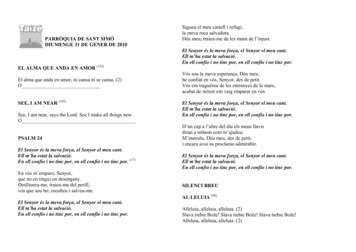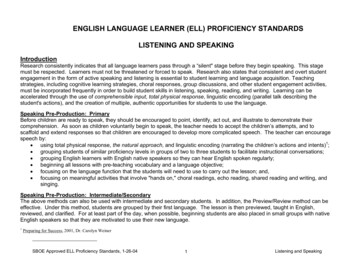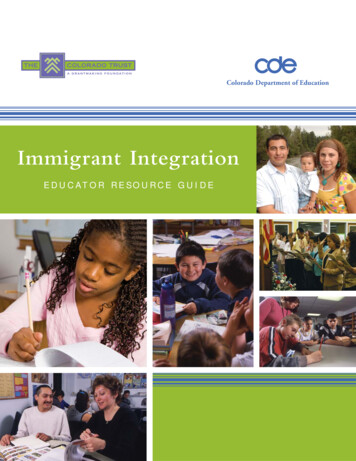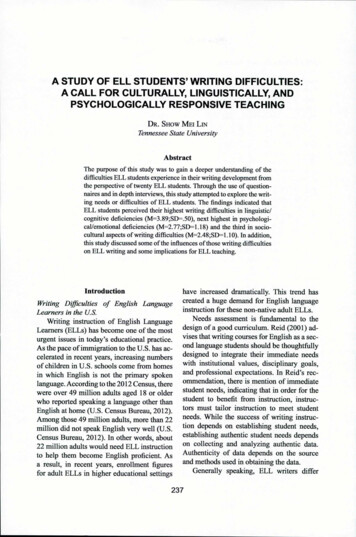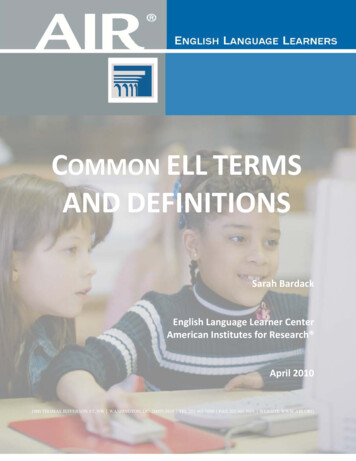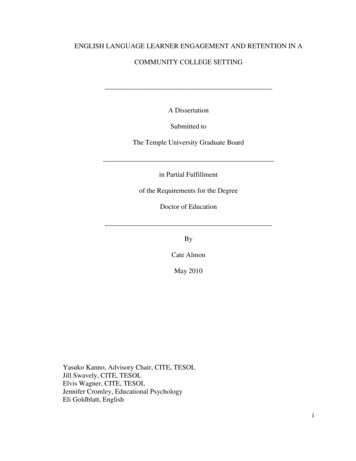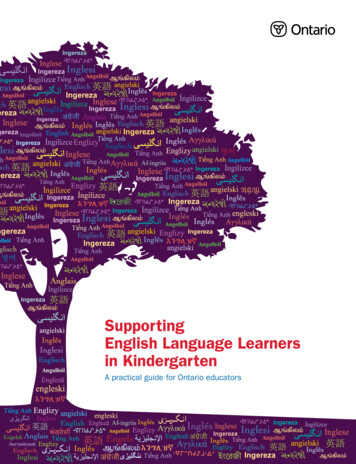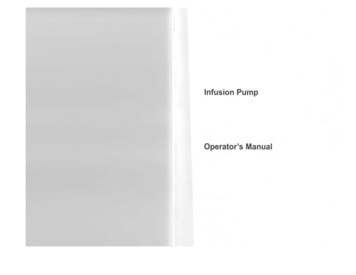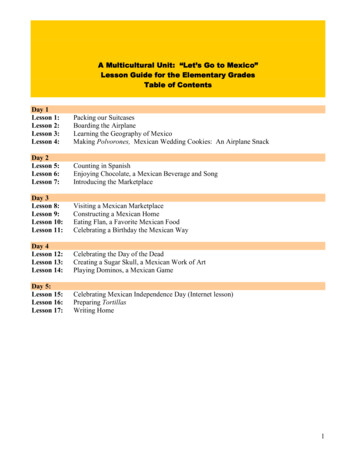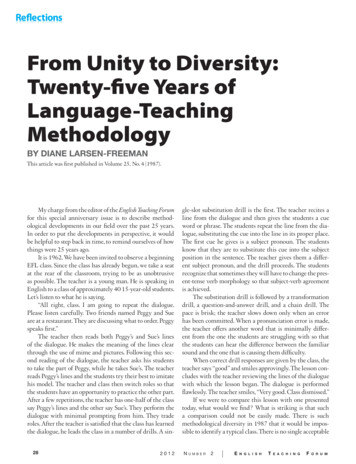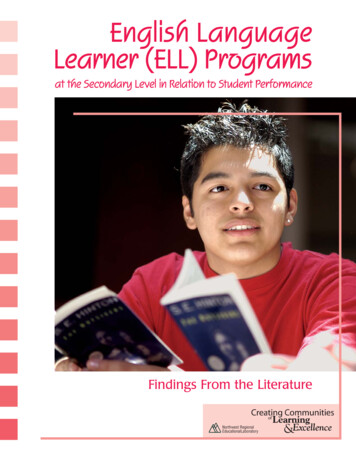
Transcription
English LanguageLearner (ELL) Programsat the Secondary Level in Relation to Student PerformanceFindings From the LiteratureNorthwest RegionalEducationalLaboratory
This publication is part of a series from NWREL to assist in schoolimprovement. Materials are available in five areas:Re-engineeringAssists schools, districts, and communities in reshaping rules, roles, structures, and relationships to build capacity for long-term improvementQuality Teaching and LearningProvides resources and strategies for teachers to improve curriculum, instruction, and assessment by promoting professional learning through reflective,collegial inquirySchool, Family, and Community PartnershipsPromotes child and youth success by working with schools to build culturallyresponsive partnerships with families and communitiesLanguage and LiteracyAssists educators in understanding the complex nature of literacy development and identifying multiple ways to engage students in literacy learningthat result in highly proficient readers, writers, and speakersAssessmentHelps schools identify, interpret, and use data to guide planning andaccountability
English LanguageLearner (ELL) Programsat the Secondary Level in Relation to Student PerformanceMarch 2004Northwest Regional Educational LaboratoryPortland, Oregon
Northwest Regional Educational Laboratory101 S.W. Main Street, Suite 500Portland, Oregon 97204503-275-9500www.nwrel.orginfo@nwrel.orgCenter for School and District Improvement Northwest Regional Educational Laboratory, 2004All Rights ReservedThis project has been funded at least in part with Federal funds from the U.S. Department of Education undercontract number ED-01-CO-0013. The content of this publication does not necessarily reflect the views or policies of the U.S. Department of Education nor does mention of trade names, commercial products, or organizations imply endorsement by the U.S. Government.ISBN 0-89354-082-X
PrefacePurposeEducational policymakers and school leaders at the secondary school level have anincreasing need for research-based information on how to structure learning for studentswho are English language learners (ELLs). This product offers them research findingsand literature from a balanced perspective in a clear, concise format. It is intended for useby state and local educational agency personnel, district decisionmakers, middle/high schoolprincipals, and school-level ELL staff. Through this publication, these users will learnabout ELL programs, practices, and interventions that are associated with student performance. They will also learn about school ELL practices that are associated with other positive factors such as improved teacher and student attitudes and behaviors. This informationwill assist secondary school staff in evaluating and/or planning their ELL programs.RationaleIn the Northwest Regional Educational Laboratory’s Regional Needs Assessment, nearly 80percent of principals in low-performing schools and districts state that they need assistance todevelop effective classroom practices that address the diverse learning needs of students. Theneed for quality research-based information about effective secondary ELL programs is drivenby growing enrollments of middle and high school students whose primary language is notEnglish. State education agencies reported limited English enrollment in 1990–1991 at 2.1million students; by 1999–2000, this segment of the school population rose to 3.7 million.Educational attainment for these students is low. They earn lower grades and score belowclassmates on most standardized reading and math tests. The No Child Left Behind Act(NCLB) specifies that by 2014 all students must achieve state standards in specifiedsubjects. School districts must disaggregate performance data by specific student populations,including ELL students. Education professionals need access to ELL research that describesprogrammatic effectiveness and provides information about the methods used by such studies.This report provides information that is not readily available in other publications. It organizes the studies and literature by rigor of research (as recommended by NCLB); it is alignedwith an ELL instructional model framework; and it focuses on the secondary school level.More than 200 studies, reports, syntheses, and literature pieces were collected and reviewedfor this publication, with 73 selected for annotation. The bibliography provides the specificsources. The following criteria were used in the literature selection process: NCLB scientifically based research guidelines as well as other literature and study types(expert opinion through experimental), instructional models, school characteristics,
student backgrounds, and/or emphasis on core academic content areas Published since 1990 (exceptions were made if the materials were deemed especially relevant or seminal) Programs and practices for ELL students at the secondary level (middle, junior, and high school) Student performance and behavior outcomes (for example, standardized tests, school and classroom assessments, attendance, and school retention rates) as well as student and teacher attitudes Relevant to one or more of the focusing questions (cited below) Information about ELL research, history, and trendsParticular attention is paid to the quality of the studies reviewed, in accordance withNCLB’s call for schools to base programs and practices on scientific research or bestevidence. The focus is on program effectiveness in terms of student success in school. Itincludes various student outcomes as indicators of program effectiveness and ELL studentsuccess, including classroom assessments and course grades; standardized test scores inEnglish language proficiency and core academic areas; student transitions to mainstreamlearning situations; dropout, graduation, and promotion rates; daily attendance; disciplinaryand suspension rates; and students’ post-secondary paths.The major focus questions addressed are: What does the literature reveal about promising secondary-level ELL programs and practices? How does the literature align with new science-based research criteria and definitions? What findings are described? Does teaching secondary ELL students in their native language as well as English resultin increased student performance? Are there specific programs, practices, and/or interventions that positively impact studentperformance? How does the literature align with a framework of ELL instructional models? What are other school and classroom recommendations? What next steps should be taken by ELL researchers?DesignThe final design of the product was determined as a result of the NWREL Quality AssurancePlan. It describes the need, audience, purpose, content, form, and development process. Theplan and draft were reviewed by a national panel with ELL expertise as well as severalNWREL staff. Suggestions and recommendations were incorporated in the final product.ApplicationsThis product is intended as a stand-alone publication. A school study group could use it as aresource in planning and design (or redesign) of secondary-level ELL programs and interventions. A facilitator with ELL expertise would enhance the use of this product. Training is notrequired for users to benefit from the publication.
Table of ContentsExecutive Summary . v1. Introduction . 12. Overview of Literature . 73. Instructional Models and the Literature. 114. Outcomes Described in the Literature . 195. Summary and Discussion of Findings . 21AppendicesA. Annotated Sources . 35B. Bibliography . 169C. Glossary of Terms . 197iii
Executive SummaryThis report focuses on secondary-level (middle and high school) English language learner(ELL) programs, approaches, and student performance. It is organized by ELL instructional program model types, research or study design types, and types of outcomes. Studentacademic performance is highlighted. Seventy-three studies from the literature are annotated. The major questions and findings are:What does the literature reveal about promising secondary-level ELL programsand practices?Most of the literature reviewed does not include sufficiently detailed descriptions of ELLprograms, practices, and/or interventions. Frequently, brief program or practice labels ortitles (e.g., “thematically integrated instruction” or “structured immersion”) are providedwithout defining program or practice features. Given this, it is difficult to draw substantiveconclusions about the effectiveness of programs/practices from the studies without more clarification about program or practice features.Are there specific programs, practices, and/or interventions that have a positiveimpact on student performance?A number of studies report positive student gains when certain specific instructionalprograms, practices, or interventions are used with secondary ELL students. On the otherhand, a few studies report no student gains with some specific practices.How does the literature align with new, scientifically based research criteria anddefinitions?Fewer than 20 of the 73 annotated studies meet rigorous scientifically based researchstandards (e.g., experimental, quasi-experimental, or multivariate models). Schools seekingcause-effect relationships so as to attempt to replicate successful practices are limited by thestudies available. Comparability among studies is also a concern because studies providevarious types and qualities of evidence.v
What findings are described?These are organized by four types: teacher behaviors and/or attitudes; student behaviorsand/or attitudes; schoolwide outcomes; and student academic and/or achievement performance. About 20 studies provide findings related to secondary-level ELL studentacademic/achievement performance.Does teaching secondary ELLs in their native language as well as English resultin increased student performance?A number of the studies/literature report that some language instruction in the nativelanguage has a positive impact on student academic performance. Some studies also reportthat the gains are not significant and/or that they vary by content area.How does the literature align with a framework of ELL instructional models?About 60 percent of the literature is organized by instructional models, such as bilingualimmersion; transitional bilingual education; pullout; structured immersion; submersion withprimary language; and so forth. About 40 percent is either unknown (not specified) orother. Most of the literature provides little detailed information or definitions about theseinstructional models/programs, other than program label.What are other school/classroom recommendations?Many ELL authors recommend that teachers and administrators implement effective schooland classroom practices to make a long-term positive impact on student behaviors and performance. These include parent-community involvement; positive climate; strong leadership; articulation between schools; quality and relevant curricula; and effective instructional strategies.What next steps should be taken by ELL researchers?The field needs additional well-designed studies, particularly empirical studies. Theseshould consist of comparison groups, random assignments when possible, and pre- and postmeasures of student outcomes, and should account for other key variables, such as schoolcontext, staff qualifications, and student demographics. ELL programs should be definedbetter and described more thoroughly in such studies. To understand the impact ofprograms or approaches on student performance better, studies should be longitudinal, notsimply over one or two years. Pre- and post- assessments in English, as well as specificcontent assessments, should include new state-level assessments being implemented underthe No Child Left Behind (NCLB) Act.vi
1. IntroductionWhat is this publication about?This publication reviews literature and presents findings concerning programs at thesecondary school level that are designed to serve English language learners (ELLs). Theseare students who come from homes where English is not the primary language spoken andwhose English language skills are assessed as needing improvement. The report organizesthe reviewed literature by ELL instructional models, by the research or study design types,and by the types of outcomes. Findings related to student academic performance are ofparticular interest, although other outcomes reported in reviewed literature are described.Major questions for this review of the relationship of ELL programs at the secondary schoollevel to student performance are: What is the nature of the literature (including empirical studies)? What findings have been described? What are the specific student performance findings? How does the literature align with a framework of ELL instructional models?Audience and purpose. Key readers include secondary-level school policymakers,district decisionmakers, school principals, and those involved with developing policyand/or educating students who are learning English as a second language. The purposeis to provide the secondary education community with a research and literature baseconcerning ELL programs and practices so that those concerned with secondary educationmay use this knowledge to select or design research-based technical assistance to schools;professional development for school personnel; and, at the district and school levels, todesign and refine programs to meet the needs of the ELL students in local contexts. Thepublication has as its ultimate goal to help ELL students learn and achieve in secondarysettings by the best means possible and not to advocate for a particular program model orapproach. This is not a process guide about how to implement ELL programs.What are secondary ELL programs? For the purposes of this review, ELL programsare planned organizational, teaching, and/or curriculum activities for the purpose of assistingELLs to meet various school/student outcomes (i.e., continued school attendance and1
academic success). Included in “secondary level” are programs offered for students inmiddle, junior high, and high schools. Programs discussed range from newcomer programsthat help recently arrived immigrant students to adjust to a new language and a new wayof schooling to programs dedicated to English language learning that “pull” students outof their mainstream classes for language instruction. Instructional practices and strategiesfor ELL students described in the reviewed literature are wide-ranging as well. Readerswill find studies that describe ELL programs using different percentages of students’home language from 100 percent to none at all and also approaches for teaching ELLstudents that place less emphasis on language learning and more on content-area learning.Instructional strategies for language learning vary depending on learning goals. Yet, evenwith all the variety in ELL students’ needs and how the literature shows they are beingtaught, there are some commonalities across approaches and some principles for ELLeducation at the secondary level that can be derived. These are discussed in thispublication.There is a growing need to educate English language learners—and to do itbetter. Throughout the United States, students at all levels are increasingly diverse culturally, racially, and linguistically. According to the U.S. Department of Education (Kindler,2002), during 2000–2001 nearly 10 percent of the total K–12 public school enrollmentthroughout the United States and territories were “limited English proficient” (estimatedas more than 4,580,000 students). ELL students are the overwhelming majority in someschools. From 1990–1991 to 2000–2001, the total ELL student population grew approximately 105 percent while, by comparison, the non-ELL school population grew just 12percent.The percent distribution of ELLs in public schools is:Grades K–3 .approximately 44 percentGrades 4–8 .more than 35 percentGrades 9–12 .approximately 19 percentAlternative schools/programs .approximately 2 percent (Kindler, 2002)Until recently, researchers concerned with ELL program effectiveness and student performance have focused their attention predominantly at the lower grades. The statistics abovecall for educational policymakers and school leaders to attend to the needs of all ELLstudents if they are serious about educating all the students in their schools.There are achievement gaps and a higher likelihood for young people to be in the dropoutpool within the racial/ethnic groups with high numbers of English language learners. RecentNational Assessment of Educational Progress (NAEP) race/ethnicity statistics show mostminority 12th-graders demonstrating lower proficiency in reading and mathematics thantheir white counterparts. In 2002, only 22 percent of Hispanic students, the largestlanguage minority, scored “at or above proficient” on the NAEP Reading Assessment,compared to white students, 44 percent of whom achieved “at or above proficient”2
(National Center for Education Statistics, 2003, p. 14). NAEP results for 2000, thelatest year available for mathematical skills, also show a wide gap between Hispanic andwhite 12th-graders. In math, only 4 percent of Hispanic students scored at or above proficient. White students scored four times higher with a 20 percent proficiency rate (NationalCenter for Education Statistics, 2001, p. 9). In 1999, 13 percent of 18- to 24-year-oldshad dropped out of school; of this number, 34 percent (the largest subgroup) wereHispanic (Jamieson, Curry, & Martinez, 2001, p. 6).As early as the fourth grade, NAEP data indicate that Latino students as a group arebehind their white, non-Latino counterparts. This distance builds up through secondaryschool. Middle school and high school grades nine and 10 are when the problems of earlyschooling come to a head or are detected, when it is more of a challenge for schools toaddress foundational learning and for students to effectively catch up (Duran, Escobar, &Wakin, 1997, reported in Montero-Sieburth & Batt, 2001, p. 356).About terminology used to describe learners of English. Describing, categorizing,and labeling the programs that serve learners of English is a difficult task, yet imperative insorting the information from the studies, reviews, and opinions. The difficulty arises initiallyfrom the nonspecific vocabulary and acronyms used in the professional field. One of theoriginal terms professionally used was “learners of English as a foreign language” (EFL) todescribe those who were learning English in their non-English-speaking home countries. Asmore immigrants came to the United States and the government and policymakers becamemore interested in them learning English, the term “learners of English as a secondlanguage” (ESL) emerged. This term was commonly used both educationally and linguistically through the 1980s.During the 1990s, emphasis moved toward cultural and linguistic recognition of thelanguage learners. Writers proposed that students might be learning English as a thirdor fourth language and thus, coined the term “learners of English as an additionallanguage” (EAL). Historically, the federal government uses its own unique term—“limited English proficient” (LEP)—in its acts, laws, and directives. However, somebelieve the term reflects a negative view of learners, not recognizing their abilities in otherlanguages, and in response, terms such as “potentially English proficient” (PEP)learners came into use.In the current decade, the terms most often seen in the literature and promoted by professional organizations are “learners of English as a second language” (ESL), “Englishspeakers of other languages” (ESOL), and “English language learners” (ELL) (Prator,1991; Sowers, 2000). The latter term—ELL—was selected for use in this document.Historical factors framing ELL research and literature. When one considers theliterature related to programs designed for ELLs, there is some relevant contextual framingthat should be in place. Native language advocacy or non-advocacy has been as much a3
human rights and political issue as a pedagogical issue. In the United States, particular civilrights court cases and ensuing federal and state civil rights legislation, federal and state legislation surrounding educational standards, and the more recent federal No Child LeftBehind Act of 2001 have shaped the notions of what types of ELL programs are appropriate in our schools. There is still some debate over whether and to what extent Englishor students’ primary language(s) should be included in ELL school programs.Detailed discussions of the nation’s ELL research history, context, and infrastructure arehandled well elsewhere (see August & Hakuta, 1997, pp. 363–373, for a good overview).It is sufficient to say here that the Lau v. Nichols equal access to education class action suitfiled in 1974 on behalf of Chinese-background students in San Francisco Public Schools waspivotal in exploring which ELL program types were thought to be appropriate for schools.Out of this case came the Supreme Court ruling that resulted in the federal governmentissuing “Lau Remedies” to those school districts found not to be in compliance with theruling for equal educational access to ELL students. The Lau Remedies, implementedbeginning in 1975, required school districts to develop and submit to the Office for CivilRights specific voluntary compliance plans. Plans submitted generally opted for an instruction mode in the students’ native language or bilingual instruction (August & Hakuta, 1997;Baker, 1988). During the 1970s, native language use in school programs for ELLsexpanded. Programs including students’ native language in instruction were combined underthe term “bilingual” (although the program goals remained English proficiency, not bilingualism). During the 1980s, with the large influx of immigrants, school districts found itunfeasible to educate each child in his or her native language. The Department of Educationdropped the Lau Remedies in 1981. A common way to educate ELLs toward the goal ofEnglish language proficiency became “pulling” them out of their other classes for shortperiods of instruction in English language skills (August & Hakuta, 1997, p. 16).Another important court case in 1981, Castaneda v. Packard, served to further define legally aschool district’s obligations programmatically toward ELLs and, in turn, the research needs. Inbrief, the case ruling required that a district’s ELL program be informed by an educationaltheory recognized as sound by experts in the field, or at least deemed a sound educationalstrategy; the program/practices used by a school/district be reasonably calculated to implementthat theory effectively; and a school’s program produce results that language barriers faced bystudents are actually being overcome. The Castaneda v. Packard case is notable from a researchperspective because it placed accountability on districts/school programs—that is, the need thatthey be based on theory and effective implementation. The ruling also shaped research in relation to programs for ELLs because schools needed research that would consider practices inrelation to effects. There was little impetus or capacity during the 1980s for underfunded stateeducation departments to create research-based standards for school programs for ELL students.A Nation at Risk (National Commission on Excellence in Education, 1983) did bringnational accountability in K–12 educational standards to the fore; in it, all the nation’sstudents were placed in the “at risk” category, not just some students such as ELLs. With4
the growing nationwide impetus for accountability to upgrade instruction and achievementfor all students and the growth in ELL student numbers, there has been a rising need forresearch on ELL program effectiveness.The Reauthorized Elementary and Secondary Education Act (ESEA) of 2001—the NoChild Left Behind (NCLB) Act—is an extension of educational reform that continuesstandards-based reform with new dimensions of accountability for state education agencies,local education agencies, school districts, and schools, which increases the need for qualityresearch about what works to help ELL students succeed in school.The major focus of NCLB is to ensure that by 2012 all students will achieve state standards in specified subjects; this is achieved through schools meeting “Adequate YearlyProgress” (AYP) standards. Individual states define AYP; however, NCLB specifies stateAYP standards should: Apply the same standards for achievement to all students Include results of “continuous and substantial” academic improvement for all students Measure the progress of all students on state assessments Include separate, measurable, annual objectives for the achievement of set groups ofstudents (LEP students constitute one of the set groups) Include graduation rates for secondary students Demonstrate that each group of students must meet or exceed the state’s measurableobjectives (U.S. Department of Education, 2002)These items have consequences for schools because NCLB specifies that states must annually assess the English proficiency of ELLs. For ELLs who have attended school in theUnited States for three consecutive years, assessment for reading/language arts must be inEnglish. NCLB puts greater pressure on schools to improve programs so ELL studentsachieve English proficiency.If accountability requirements for AYP are not met, there are consequences in NCLB. Incases of schoolwide improvement and in programs targeted to assist particular student populations, Title I schools must use strategies founded on scientifically based research (Wong,Nicotera, & Manning, 2002, p. 9; NCLB Title I, Part A 1114/b/1/B/ii, 1115/c/1/C).Scientifically based research (SBR) must be applied to technical assistance, professionaldevelopment activities, and instructional strategies (Wong, Nicotera, & Manning, 2002,p. 9; NCLB Title I, Part A 1116/b/4/B-C).Language instruction for limited English proficient and immigrant students.Limited English proficient (LEP) federal funds are to be used for increasing English proficiency by providing programs based on scientifically based research that demonstrates theeffectiveness of the program in increasing English proficiency and student academic achievement in the core academic subjects, as well as high-quality professional development toteachers, principals, administrators, and other school or community-based organizational5
personnel. LEP funds are also authorized for use to: Upgrade programs and effective instructional strategies Improve instructional program(s) by identifying, acquiring, and upgrading curricula,instructional materials, educational software, and assessment procedures Provide intensified instruction (tutorials and academic or vocational education) Develop language instruction educational programs coordinated with other relevantprograms and services Improve English proficiency and academic achievement for LEP tml)School districts with a significant increase in their immigrant student population comparedto the previous two-year period may also be eligible for immigrant funds. Activitiessupported through these funds may include the following: Family literacy services, parent outreach Support for personnel, including aides, to provide services to immigrants Tutorials, mentoring, and academic or career counseling for immigrants Acquisition of curricular materials, educational software, and technologies Basic instructional services Other instructional services designed to assist immigrants to achieve in school Activities coordinated with community-based organizations or businesses to assistparents of immigrants through comprehensive community tml)What is meant by scientifically based research? The term “scientifically basedresearch” appears throughout NCLB, and is defined within the act as research that: Applies rigorous, systematic, and objective procedures Employs a systematic and empirical methodology Involves rigorous data analyses that test hypotheses and justify the general conclusions Produces results that are valid across evaluators and multiple observations Has been accepted by a peer-reviewed journal or a comparable review(Wong, Nicotera, & Manning, 2002, p. 9; NCLB Title I, Part B, 1208/6)To remain eligible for federal funding in the areas covered by NCLB, Local EducationalAgencies/districts and schools are to make the determinations about the research rigor ofselected programs, curricula, and materials. NCLB does not identify the specificprograms or strategies proven effective through scientifically based research. NCLB specifies that schools must consider to what extent new instructional programs and curriculaand models are based on SBR. The level of empirical evidence that supports such newpractices, programs, and models needs
ulation between schools; quality and relevant curricula; and effective instructional strategies. What next steps should be taken by ELL researchers? The field needs additional well-designed studies, particularly empirical studies. These should consist of comparison groups, random assignments when possible, and pre- and post-
